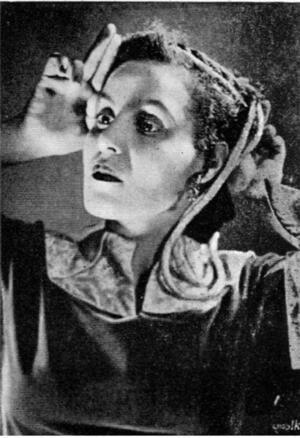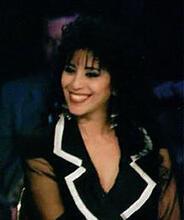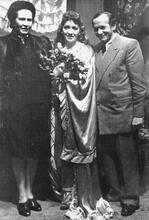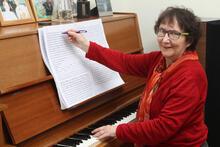Brachah Zefira
Brachah Zefira in the 1930s.
From Wikimedia Commons.
Brachah Zefira was a seminal figure in the world of Israeli song and among its most colorful and influential personalities in the pre-State period. Zefira studied at the Kedmah music school run by Sidney Sielbefore traveling to Berlin to study at the studio of Max Reinhardt. In Berlin, she made the acquaintance of the pianist Nahum Nardi and they began performing together. The appearances of the duo, who married during this period, were a great success and they began touring. After eight years of demanding joint performances, relations between Zefira and Nardi deteriorated and they divorced. Zefira took up drawing and displayed her work at several exhibitions. In her footsteps, an entire wave of Yemenite women singers arose, whose singing style emphasized their Oriental roots.
Family and Upbringing
Brachah Zefira was a seminal figure in the world of Israeli song and among its most colorful and influential personalities in the pre-State period. Few records remain of her family, her date of birth, or her childhood, but it is known that her father, Yosef Zefira, immigrated to Palestine from the city of Sanaa in Yemen in 1877 and settled in Jerusalem’s Nahalat Zvi neighborhood, which was founded that year. It was there that he established his home after marrying Na’ama (née Amrani), also a native of Yemen. Their daughter Brachah was born in 1910. Her mother died in childbirth and her father was overcome by typhus when she was three.
In the absence of an orphanage for Yemenite children, Zefira was given over to a Yemenite adoptive family who lived nearby. Shortly thereafter, she was moved to a different family, who lived in the Bukharan Quarter of Jerusalem. The residents of this neighborhood, then considered one of the most splendid in the city, had come to Palestine from Bukhara, Tashkent, and Samarkand. Three years later, the girl was passed to another Mizrahi adoptive family, in the Yemin Moshe (formerly Montefiore) neighborhood, most of whose residents at the time hailed from Salonika, Greece.
In every Jerusalem neighborhood in the early twentieth century, the synagogue played a central role in the life of the neighborhood and its inhabitants, who were, for the most part, religiously observant or traditional. Each of the families that participated in Zefira’s upbringing led a similarly traditional lifestyle; as a result, she grew up surrounded by the melodies of religious liturgy and poems (piyyutim); songs for festivals and family celebrations (weddings, Lit. "son of the commandment." A boy who has reached legal-religious maturity and is now obligated to fulfill the commandmentsbar mitzvahs, and circumcisions, among others); and songs of personal and communal mourning. Zefira absorbed and integrated the unique musical qualities of every milieu of her childhood, as was ultimately reflected in her music.
Like many young girls from Mizrahi families, Zefira was sent to study at a school in Jerusalem’s Old City and later at the Lemel School. On their way to school, the girls heard the Arab songs that echoed through the streets of Jerusalem at the time and, as she later recounted in her book Many Voices, adapted Hebrew words to them, including the poems of Hayyim Nahman Bialik (1873–1934) and others.
Artistic Training
In approximately 1924 Zefira transferred to the Me’ir Shefeyah educational village near Zikhron Ya’akov, run by Moshe Calwary (1876–1944). His wife, Hadassah, who worked as a teacher at the institution, was the first to take notice of Zefira’s voice and her unique musical talent. With her support and encouragement, Zefira began to appear in concert on Friday nights, singing the zemirot Shabbat (Sabbath songs) she had absorbed as a young child in the various Jerusalem neighborhoods. Zefira’s performances were enthusiastically received both by her fellow students (most of whom were also of Mizrahi extraction) and by the teachers and counselors at the institution, who were from Ashkenazi families.
As a result of these appearances, the school administration concluded that Zefira should receive a proper musical education. Accordingly, she was sent back to Jerusalem to study at the Kedmah music school run by Sidney Siel. Her studies there lasted only a few months since her teachers at the Conservatory recommended that she study acting instead of music. Zefira moved to Tel Aviv, where she was accepted by the Palestine Theater and its acting studio, founded by Menahem Gnessin. After mounting several plays, including The Dybbuk, the theater closed. In 1927, Zefira became a member of the satirical theater troupe Ha-Kumkum, founded by Avigdor Hameiri in Tel Aviv. She sang and acted there until the theater’s dissolution in 1929.
During this period, Zefira lived in the Neveh Zedek quarter of Tel Aviv, where she became familiar with Yemenite Jewish traditions, in particular the community’s songs, which captivated her. As a result, she began studying the Yemenite singing tradition with Yehiel Adaki, who was engaged in collecting and publicizing Yemenite music.
Upon the recommendation of Alexander Diki, a Russian director at the Habimah theater, and with the support of Meir Dizengoff, the mayor of Tel Aviv, Zefira traveled to Berlin to continue her studies in acting and music at the studio of Max Reinhardt. In Berlin, Zefira was exposed to the grandeur of the classical world. While studying at Reinhardt’s school, she became famous for always appearing with her hair loose and her feet bare, as had been her practice in Palestine (“out of a desire to feel the earth,” as she often explained). In Berlin, she sang before such prominent figures as Albert Einstein and Max Nordau, who remarked that she “sings like a young shepherdess in the mountains.”
Work With and Marriage to Nahum Nardi
Zefira also performed as a singer in various Jewish settings in Berlin. At one of her appearances, at the city’s Jewish community center, she made the acquaintance of the pianist Nahum Nardi (Narodietzky, 1901–1977), who had immigrated to Palestine from Russia in 1923 and traveled to Berlin in 1929 to continue his studies.
Of their meeting, Zefira wrote in her book: “That very evening … I begged him to sit at the piano and play the songs I would sing to him and try to improvise an accompaniment. I sang Bialik’s ‘Yesh Li Gan’ and ‘Bein Nahar Prat’ for him, and Sephardi piyyutim … and other songs that I was used to singing from Shefeyah. He was a quick study with an excellent ear and a light touch at the piano, and was familiar with Hebrew lyrics, although from a traditional galut (Diaspora) perspective. His playing and the simple harmonies electrified me. I felt that the song had taken on new sounds …” (p. 16).
An impresario who heard them in Berlin began to organize a series of concerts for the duo that same year (1929) in Germany, and later, other parts of Europe. Of one of their appearances in Warsaw, on October 6, 1929, a critic wrote in the Haynt newspaper: “At their performance, they sang Hebrew folks songs from Palestine, Yemenite songs and other Oriental songs, arranged for the first time by the composer and pianist Nahum Nardi … Zefira not only sings the songs but acts them rather dramatically, offering the audience a living portrait of the East” (S.P., Haynt, October 7, 1929).
The success of their performances in Warsaw and Berlin encouraged Zefira and Nardi to continue working together; upon their return from Europe in 1930, they began appearing in Palestine. Their show, entitled “Mi-Zimrat ha-Aretz” (Songs of Palestine), included songs from Yemen, Arab songs, shepherds’ tunes, traditional zemirot, prayers, and Sephardi and Mizrahi songs. Zefira sang from the repertoire she had absorbed and internalized in her childhood and early adult years, in particular traditional melodies whose words she replaced with those of Bialik, Jacob Fichmann (1881–1958), Yehuda Karni (1884–1949), Abraham Broides (1907–1979) and others, while Nardi accompanied her on the piano. They also added to their program children’s songs composed by Nardi.
The appearances of the duo, who married during this period, were a great success. As Zefira writes in her book: “We continued to work and create for eight years. We put on numerous songs and programs. On festive occasions, we sang before schoolchildren throughout the country. We prepared special programs for each holiday. We traveled among the kibbutzim … During this period, we traveled to the Jewish communities of Alexandria and Cairo. We made four trips through Europe’s Jewish centers and in the United States we did a grand concert tour in honor of the twenty-fifth anniversary of the Arbeiter Farband [sic].”
Ethnic Integration on the Palestinian Stage
The Zefira-Nardi duo were at the forefront of ethnic integration on the Palestinian stage and in the local music scene of the late 1920s and early 1930s. In late March 1936, when the Palestine Broadcasting Service transmitted the country’s first radio show from a studio set up at the Palace Hotel in Tel Aviv, the program opened with Zefira singing “La-Midbar Sa’enu,” (lyrics by Alexander Penn, 1906–1972) the first song to be broadcast in Palestine.
During Zefira and Nardi’s concert tour in the United States in 1937, they recorded three albums with the prestigious Columbia record company. The recordings, which were among the first to appear in Hebrew, circulated in Jewish communities around the world and served as a “calling card” of sorts for the nascent field of Hebrew song in Palestine.
By the time the duo returned to Palestine after their concert tour, Zefira had become a super-star of her day and their appearances were considered an integral part of the Tel Aviv cultural scene. Huge crowds gathered at the Beit Ha-Am and Gan Rinah halls, where the duo appeared with no microphone, set, or orchestral accompaniment.
In the summer of 1939 Zefira appeared for the first time in concert with the Palestine Symphony Orchestra (later the Israel Philharmonic), performing only four songs. In 1942, however, the Orchestra held a special concert at Ganei Ha-Ta’arukhah in Tel Aviv with Zefira as soloist. This was a historic occasion from several standpoints, since it marked the first time that a performer appeared on stage with the Orchestra singing Mizrahi and Ladino songs.
After eight years of demanding joint performances, relations between Zefira and Nardi deteriorated and they divorced. Their daughter, Na’amah, who became a singer, later performed at La Scala in Milan. Zefira now turned to other composers in Palestine to arrange authentic popular material for her; among her collaborators were Paul Ben-Haim (1897–1984), Oedoen Partos (1909–1977), Marc Lavry (1903–1967), Emanuel Amiran (1909–1993), and Yedidyah Admon (1897–1982).
Zefira later married Ben-Ami Zilber, a violinist with the Palestine Symphony Orchestra. They had one son, Ariel, who today ranks among the most respected singer/songwriters in Israeli music. In 1966, she was awarded the Joel Engel Prize for her contribution to Israeli musical research.
After losing her voice, Zefira took up drawing and even displayed her work at several exhibitions. In her footsteps, an entire wave of Yemenite women singers arose, whose singing style emphasized their Oriental roots. The most prominent of these were Esther Gamlielit, Hannah Aharoni, Shoshana Damari, Ahuvah Zadok, Ofra Haza, and Ahinoam Nini.
Brachah Zefira passed away on April 1, 1990.
Discography
Many of Bracha Zefira’s recordings were made in radio studios. Below is a partial breakdown of some of her most important recordings.
- The first songs were recorded during her first visit to the United States in 1937. At that time, three song records were recorded (at a speed of 78 revolutions per minute), with the singer accompanied by pianist Nahum Nardi, her husband.
- In the years 1947-1948, songs were recorded in various studios.
- In 1960, an Erich Nagan record, “Who will build a house in Tel Aviv,” from the songs of Little Tel Aviv, was published by CBS.
- In 1966, the record “30 Years of Music in Israel,” was produced by Feta Marconi from Paris.
Flamm, Gila. “Brachah Zefira’s Musical Oeuvre in Palestine” (Hebrew). Master’s thesis, Hebrew University of Jerusalem, n.d.
Zefira, Brachah. Many Voices (Hebrew). Tel Aviv: 1978.








